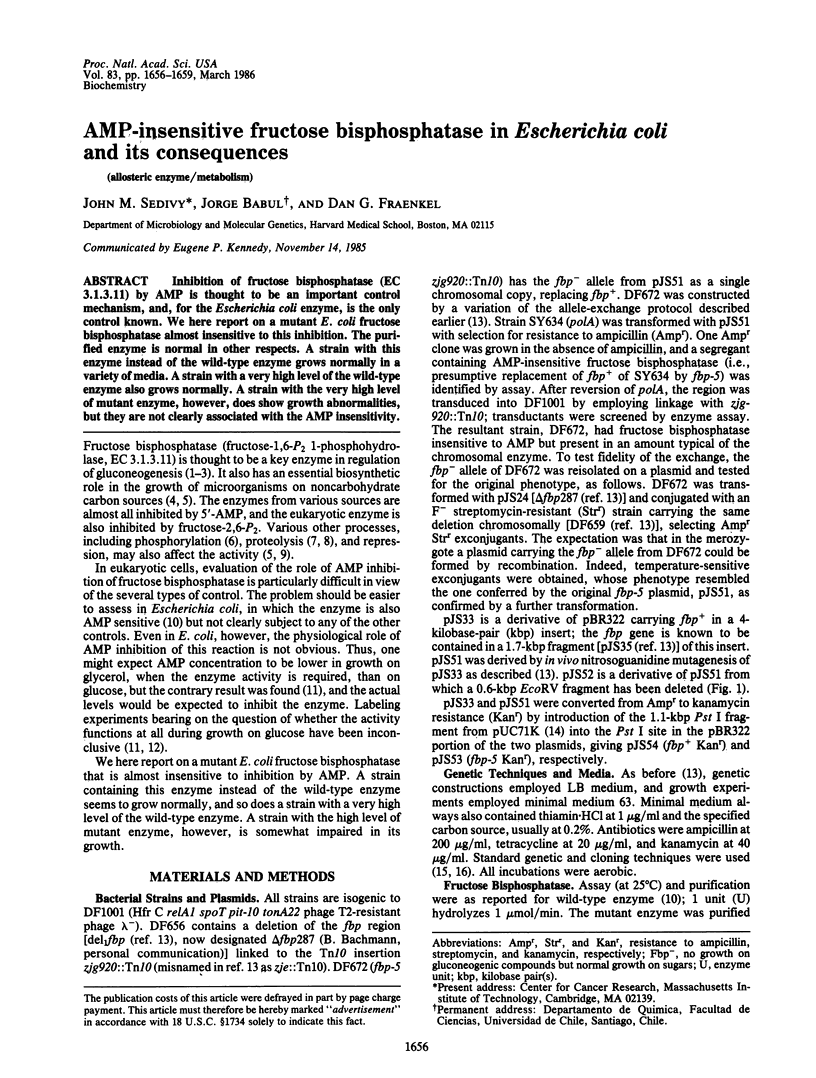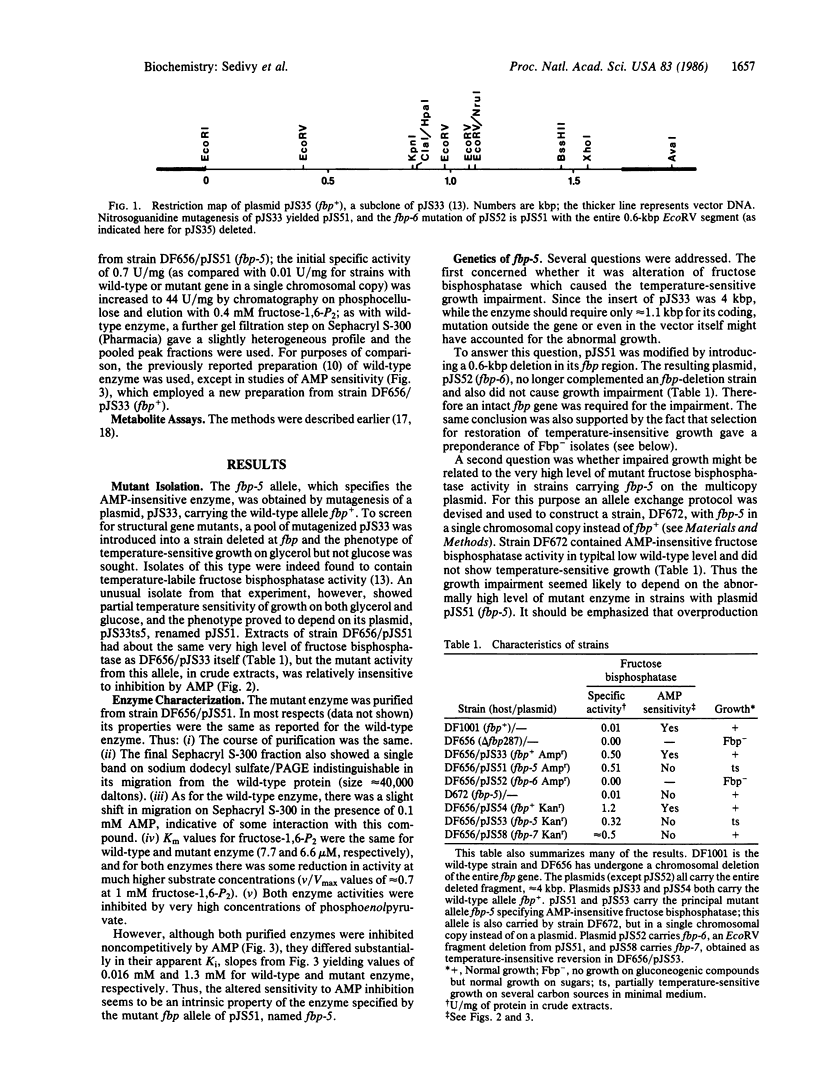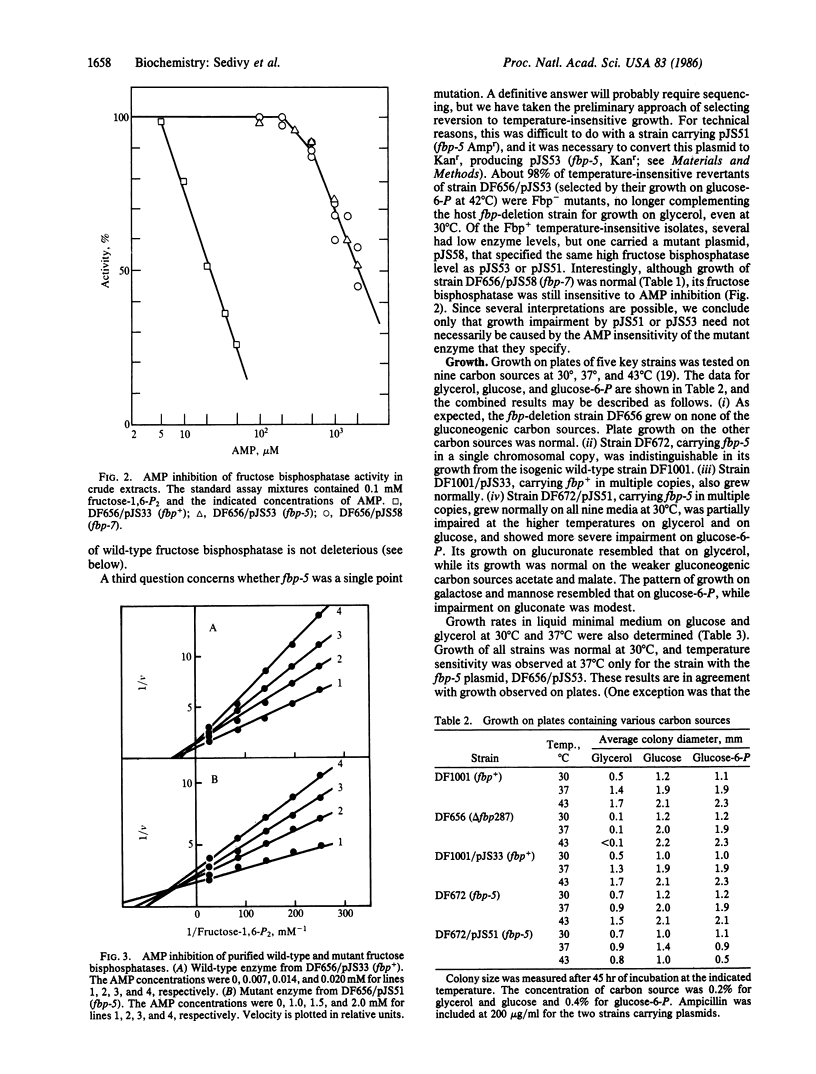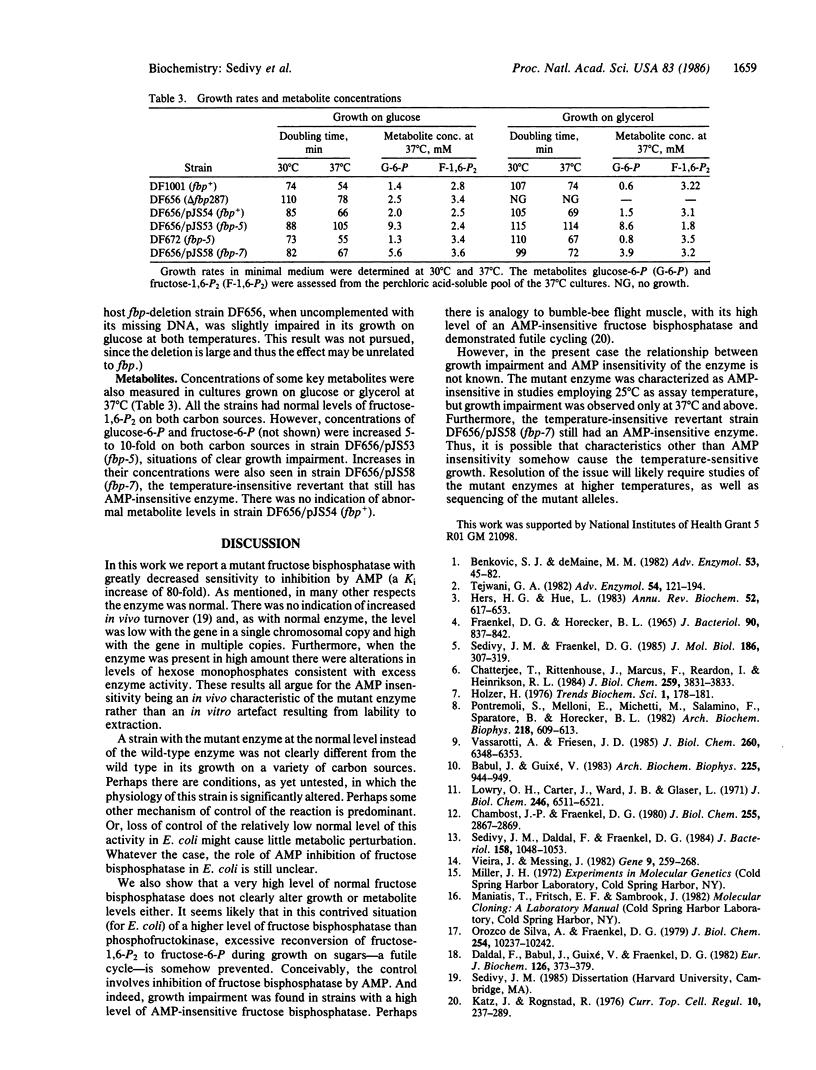Abstract
Inhibition of fructose bisphosphatase (EC 3.1.3.11) by AMP is thought to be an important control mechanism, and, for the Escherichia coli enzyme, is the only control known. We here report on a mutant E. coli fructose bisphosphatase almost insensitive to this inhibition. The purified enzyme is normal in other respects. A strain with this enzyme instead of the wild-type enzyme grows normally in a variety of media. A strain with a very high level of the wild-type enzyme also grows normally. A strain with the very high level of mutant enzyme, however, does show growth abnormalities, but they are not clearly associated with the AMP insensitivity.
Full text
PDF



Selected References
These references are in PubMed. This may not be the complete list of references from this article.
- Babul J., Guixé V. Fructose bisphosphatase from Escherichia coli. Purification and characterization. Arch Biochem Biophys. 1983 Sep;225(2):944–949. doi: 10.1016/0003-9861(83)90109-1. [DOI] [PubMed] [Google Scholar]
- Benkovic S. J., deMaine M. M. Mechanism of action of fructose 1,6-bisphosphatase. Adv Enzymol Relat Areas Mol Biol. 1982;53:45–82. doi: 10.1002/9780470122983.ch2. [DOI] [PubMed] [Google Scholar]
- Chambost J. P., Fraenkel D. G. The use of 6-labeled glucose to assess futile cycling in Escherichia coli. J Biol Chem. 1980 Apr 10;255(7):2867–2869. [PubMed] [Google Scholar]
- Chatterjee T., Rittenhouse J., Marcus F., Reardon I., Heinrikson R. L. Identification of the in vivo and in vitro phosphorylation sites of rat liver fructose 1,6-bisphosphatase. J Biol Chem. 1984 Mar 25;259(6):3831–3833. [PubMed] [Google Scholar]
- Daldal F., Babul J., Guixé V., Fraenkel D. G. An alteration in phosphofructokinase 2 of Escherichia coli which impairs gluconeogenic growth and improves growth on sugars. Eur J Biochem. 1982 Aug;126(2):373–379. doi: 10.1111/j.1432-1033.1982.tb06790.x. [DOI] [PubMed] [Google Scholar]
- Hers H. G., Hue L. Gluconeogenesis and related aspects of glycolysis. Annu Rev Biochem. 1983;52:617–653. doi: 10.1146/annurev.bi.52.070183.003153. [DOI] [PubMed] [Google Scholar]
- Katz J., Rognstad R. Futile cycles in the metabolism of glucose. Curr Top Cell Regul. 1976;10:237–289. doi: 10.1016/b978-0-12-152810-2.50013-9. [DOI] [PubMed] [Google Scholar]
- Lowry O. H., Carter J., Ward J. B., Glaser L. The effect of carbon and nitrogen sources on the level of metabolic intermediates in Escherichia coli. J Biol Chem. 1971 Nov;246(21):6511–6521. [PubMed] [Google Scholar]
- Pontremoli S., Melloni E., Michetti M., Salamino F., Sparatore B., Horecker B. L. On the mechanism of inhibition of fructose 1,6-bisphosphatase by fructose 2,6-bisphosphate. Arch Biochem Biophys. 1982 Oct 15;218(2):609–613. doi: 10.1016/0003-9861(82)90386-1. [DOI] [PubMed] [Google Scholar]
- Sedivy J. M., Daldal F., Fraenkel D. G. Fructose bisphosphatase of Escherichia coli: cloning of the structural gene (fbp) and preparation of a chromosomal deletion. J Bacteriol. 1984 Jun;158(3):1048–1053. doi: 10.1128/jb.158.3.1048-1053.1984. [DOI] [PMC free article] [PubMed] [Google Scholar]
- Sedivy J. M., Fraenkel D. G. Fructose bisphosphatase of Saccharomyces cerevisiae. Cloning, disruption and regulation of the FBP1 structural gene. J Mol Biol. 1985 Nov 20;186(2):307–319. doi: 10.1016/0022-2836(85)90107-x. [DOI] [PubMed] [Google Scholar]
- Tejwani G. A. Regulation of fructose-bisphosphatase activity. Adv Enzymol Relat Areas Mol Biol. 1983;54:121–194. doi: 10.1002/9780470122990.ch3. [DOI] [PubMed] [Google Scholar]
- Vassarotti A., Friesen J. D. Isolation of the fructose-1,6-bisphosphatase gene of the yeast Schizosaccharomyces pombe. Evidence for transcriptional regulation. J Biol Chem. 1985 May 25;260(10):6348–6353. [PubMed] [Google Scholar]
- Vieira J., Messing J. The pUC plasmids, an M13mp7-derived system for insertion mutagenesis and sequencing with synthetic universal primers. Gene. 1982 Oct;19(3):259–268. doi: 10.1016/0378-1119(82)90015-4. [DOI] [PubMed] [Google Scholar]
- de Silva A. O., Fraenkel D. G. The 6-phosphogluconate dehydrogenase reaction in Escherichia coli. J Biol Chem. 1979 Oct 25;254(20):10237–10242. [PubMed] [Google Scholar]


